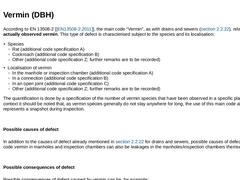
|
According to EN 13508-2 [ [EN13508-2:2011]], the main code “Vermin”, as with drains and sewers ( (Vermin (BBH))), relates to actually observed vermin. This type of defect is characterised subject to the species and its localisation: -
Species
-
Rat (additional code specification A)
-
Cockroach (additional code specification B)
-
Other (additional code specification Z; further remarks are to be recorded)
-
Localisation of vermin
-
In the manhole or inspection …
|
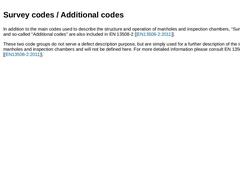
|
In addition to the main codes used to describe the structure and operation of manholes and inspection chambers, “Survey codes” and so-called “Additional codes” are also included in EN 13508-2 [ [EN13508-2:2011]]. These two code groups do not serve a defect description purpose, but are simply used for a further description of the inspected manholes and inspection chambers and will not be defined here. For more detailed information please consult EN … |
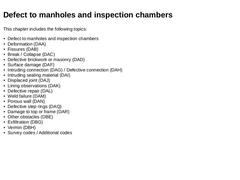
|
|
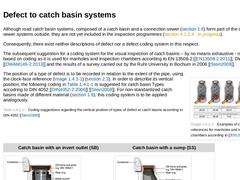
|
Although road catch basin systems, composed of a catch basin and a connection sewer ( (Catch basin systems)) form part of the drain and sewer systems outside, they are not yet included in the inspection programmes (section 4.1.2.4 - in progress). Consequently, there exist neither descriptions of defect nor a defect coding system in this respect. The subsequent suggestion for a coding system for the visual inspection of catch basins – by no means exhaustive - … |
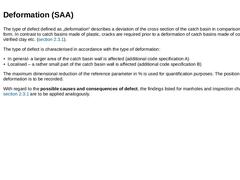
|
The type of defect defined as „deformation“ describes a deviation of the cross section of the catch basin in comparison to its original form. In contrast to catch basins made of plastic, cracks are required prior to a deformation of catch basins made of concrete, vitrified clay etc. ( (Deformation (DAA))). The type of defect is characterised in accordance with the type of deformation: -
In general- a larger area of the catch basin wall is affected (…
|
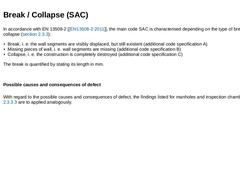
|
In accordance with EN 13508-2 [ [EN13508-2:2011]], the main code SAC is characterised depending on the type of break or as collapse ( (Break / Collapse (DAC))): -
Break, i. e. the wall segments are visibly displaced, but still existent (additional code specification A)
-
Missing pieces of wall, i. e. wall segments are missing (additional code specification B)
-
Collapse, i. e. the construction is completely destroyed (additional code specification C)…
|
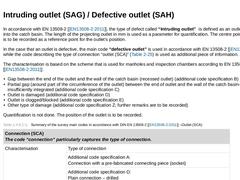
|
In accordance with EN 13508-2 [ [EN13508-2:2011]], the type of defect called “Intruding outlet” is defined as an outlet projecting into the catch basin. The length of the projecting outlet in mm is used as a parameter for quantification. The centre point of the outlet is to be recorded as a reference point for the outlet’s position. In the case that an outlet is defective, the main code “defective outlet” is used in accordance with EN 13508-2 [ [EN13508-… |
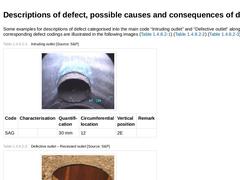
|
Some examples for descriptions of defect categorised into the main code “Intruding outlet” and “Defective outlet” along with the corresponding defect codings are illustrated in the following images (Image 2‑198) (Image 2‑199) (Image 2‑200). (Table: Intruding outlet) (Table: Defective outlet – Recessed outlet ) (Table: Defective outlet – Outlet blocked ) Possible causes and consequences of defect With regard to the possible causes and consequences of defect, … |
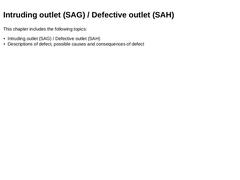
|
|
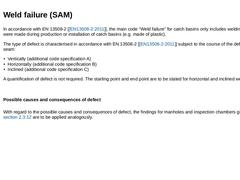
|
In accordance with EN 13508-2 [ [EN13508-2:2011]], the main code “Weld failure” for catch basins only includes welding seams that were made during production or installation of catch basins (e.g. made of plastic). The type of defect is characterised in accordance with EN 13508-2 [ [EN13508-2:2011]] subject to the course of the defective welding seam: -
Vertically (additional code specification A)
-
Horizontally (additional code specification B)
-
Inclined (…
|
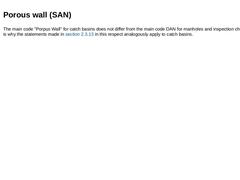
|
The main code "Porpus Wall" for catch basins does not differ from the main code DAN for manholes and inspection chambers. That is why the statements made in (Porous wall (DAN)) in this respect analogously apply to catch basins. |
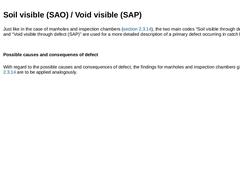
|
Just like in the case of manholes and inspection chambers ( (Soil visible (DAO) / Void visible (DAP))), the two main codes “Soil visible through defect (SAO)” and “Void visible through defect (SAP)” are used for a more detailed description of a primary defect occurring in catch basins. Possible causes and consequenes of defect With regard to the possible causes and consequences of defect, the findings for manholes and inspection chambers given in (… |
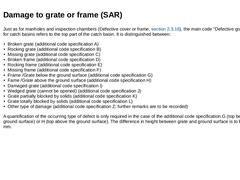
|
Just as for manholes and inspection chambers (Defective cover or frame, (Damage to top or frame (DAR))), the main code “Defective grate or frame” for catch basins refers to the top part of the catch basin. It is distinguished between: -
Broken grate (additional code specification A)
-
Rocking grate (additional code specification B)
-
Missing grate (additional code specification C)
-
Broken frame (additional code specification D)
-
Rocking frame (additional …
|
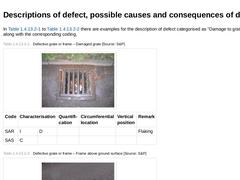
|
In Image 2‑202 to Image 2‑206 there are examples for the description of defect categorised as “Damage to grate or frame” along with the corresponding coding. (Table: Defective grate or frame – Damaged grate) (Table: Defective grate or frame – Frame above ground surface ) (Table: Defective grate or frame – Grate partially blocked by solids ) (Table: Defective grate or frame – Grate below ground surface ) Possible causes of defect Possible causes of defect … |
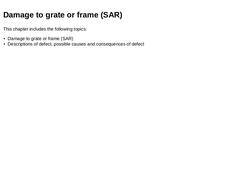
|
|
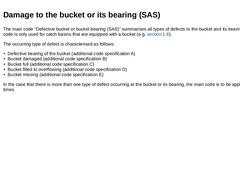
|
The main code “Defective bucket or bucket bearing (SAS)” summarises all types of defects to the bucket and its bearing. This main code is only used for catch basins that are equipped with a bucket (e.g. (Catch basin systems)). The occurring type of defect is characterised as follows: -
Defective bearing of the bucket (additional code specification A)
-
Bucket damaged (additional code specification B)
-
Bucket full (additional code specification C)
-
Bucket …
|
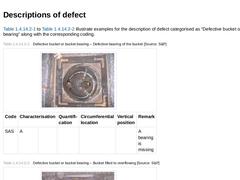
|
Image 2‑207 to Image 2‑211 illustrate examples for the description of defect categorised as “Defective bucket or bucket bearing” along with the corresponding coding. (Table: Defective bucket or bucket bearing – Defective bearing of the bucket) (Table: Defective bucket or bucket bearing – Bucket filled to overflowing ) (Table: Defective bucket or bucket bearing – Bucket filled to overflowing ) (Table: Defective bucket or bucket bearing – Bucket full) (… |
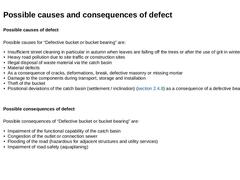
|
Possible causes of defect Possible causes for “Defective bucket or bucket bearing” are: -
Insufficient street cleaning in particular in autumn when leaves are falling off the trees or after the use of grit in winter
-
Heavy road pollution due to site traffic or construction sites
-
Illegal disposal of waste material via the catch basin
-
Material defects
-
As a consequence of cracks, deformations, break, defective masonry or missing mortar
-
Damage to the …
|
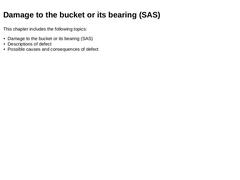
|
|
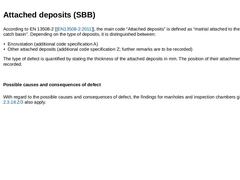
|
According to EN 13508-2 [ [EN13508-2:2011]], the main code “Attached deposits” is defined as “matrial attached to the wall of the catch basin”. Depending on the type of deposits, it is distinguished between: -
Encrustation (additional code specification A)
-
Other attached deposits (additional code specification Z; further remarks are to be recorded)
The type of defect is quantified by stating the thickness of the attached deposits in mm. The position … |
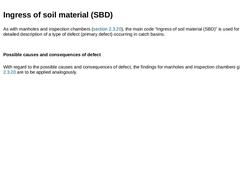
|
As with manholes and inspection chambers ( (Ingress of soil material (DBD))), the main code “Ingress of soil material (SBD)” is used for a more detailed description of a type of defect (primary defect) occurring in catch basins. Possible causes and consequences of defect With regard to the possible causes and consequences of defect, the findings for manholes and inspection chambers given in (Ingress of soil material (DBD)) are to be applied analogously. |
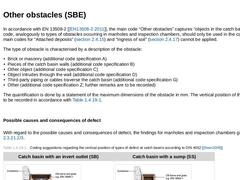
|
In accordance with EN 13508-2 [ [EN13508-2:2011]], the main code “Other obstacles” captures “objects in the catch basin”. This code, analogously to types of obstacles occurring in manholes and inspection chambers, should only be used in the case that the main codes for “Attached deposits” ( (Attached deposits (SBB))) and “Ingress of soil” ( (Ingress of soil material (SBD))) cannot be applied. The type of obstacle is characterised by a description … |
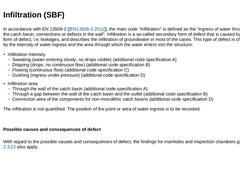
|
In accordance with EN 13508-2 [ [EN13508-2:2011]], the main code “Infiltration” is defined as the “ingress of water through the wall of the catch basin, connections or defects in the wall”. Infiltration is a so-called secondary form of defect that is caused by a primary form of defect, i.e. leakages, and describes the infiltration of groundwater in most of the cases. This type of defect is characterised by the intensity of water ingress and the area … |
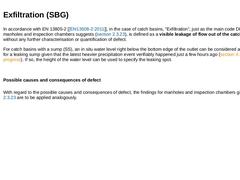
|
In accordance with EN 13805-2 [ [EN13508-2:2011]], in the case of catch basins, “Exfiltration”, just as the main code DBG for manholes and inspection chambers suggests ( (Exfiltration (DBG))), is defined as a visible leakage of flow out of the catch basin without any further characterisation or quantification of defect. For catch basins with a sump (SS), an in situ water level right below the bottom edge of the outlet can be considered an indication … |
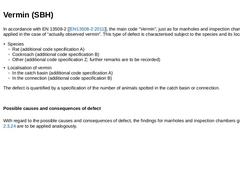
|
In accordance with EN 13508-2 [ [EN13508-2:2011]], the main code “Vermin”, just as for manholes and inspection chambers, is only applied in the case of “actually observed vermin”. This type of defect is characterised subject to the species and its localisation: -
Species
-
Rat (additional code specification A)
-
Cockroach (additional code specification B)
-
Other (additional code specification Z; further remarks are to be recorded)
-
Localisation of vermin
|